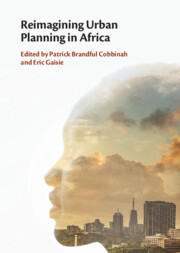Book contents
- Reimagining Urban Planning in Africa
- Reimagining Urban Planning in Africa
- Copyright page
- Contents
- Contributors
- Foreword
- Preface
- Acknowledgements
- Abbreviations
- Part I Understanding Sustainable Urban Planning in Africa
- Part II Case Studies on Urban Planning in African Countries
- Part III Sustainable Urban Planning in Africa
- 14 On the Need for Sustainable Digital Urban Infrastructure in Twenty-First-Century South African Cities
- 15 The South African Landownership Struggle
- 16 The 2030 Agenda, Climate Urbanism and Urban Planning in Zimbabwe
- 17 Urban Planning and Quality of Life of Urban Residents in Africa
- 18 Realising Rights in Complex Informal Settlements Contexts
- 19 Participatory Design Won’t Fix Unequal Southern African Cities
- 20 Enabling Smart Mobility in African Cities
- 21 On the Future of Urban Planning in Africa
- Index
- References
17 - Urban Planning and Quality of Life of Urban Residents in Africa
from Part III - Sustainable Urban Planning in Africa
Published online by Cambridge University Press: 07 December 2023
- Reimagining Urban Planning in Africa
- Reimagining Urban Planning in Africa
- Copyright page
- Contents
- Contributors
- Foreword
- Preface
- Acknowledgements
- Abbreviations
- Part I Understanding Sustainable Urban Planning in Africa
- Part II Case Studies on Urban Planning in African Countries
- Part III Sustainable Urban Planning in Africa
- 14 On the Need for Sustainable Digital Urban Infrastructure in Twenty-First-Century South African Cities
- 15 The South African Landownership Struggle
- 16 The 2030 Agenda, Climate Urbanism and Urban Planning in Zimbabwe
- 17 Urban Planning and Quality of Life of Urban Residents in Africa
- 18 Realising Rights in Complex Informal Settlements Contexts
- 19 Participatory Design Won’t Fix Unequal Southern African Cities
- 20 Enabling Smart Mobility in African Cities
- 21 On the Future of Urban Planning in Africa
- Index
- References
Summary
The rapid rate of urbanisation in Africa accompanied by a myriad of socio-economic, physical and environmental challenges and the persistence of these challenges have called into question the effectiveness of urban planning in managing this phenomenon to achieve an improved quality of life. This chapter, through an extensive review of the literature, examines the magnitude of Africa’s urbanisation challenges, the planning response to those challenges and the effects of planning on the quality of life. The chapter notes a peculiar urbanisation with rapid human agglomeration but without commensurate urban facilities and services. Urban planning is characterised by heavy reliance on western planning models that has made it less responsive to the socio-economic, cultural and spatial requirements of the people, thus making cities less liveable. The chapter calls for a re-examination of urban planning practice and suggests measures that could be explored to reposition urban planning for effective urban management in Africa.
- Type
- Chapter
- Information
- Reimagining Urban Planning in Africa , pp. 303 - 324Publisher: Cambridge University PressPrint publication year: 2023



